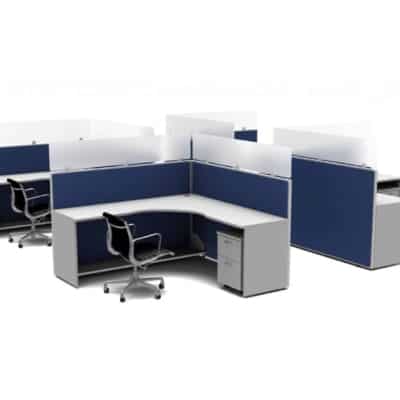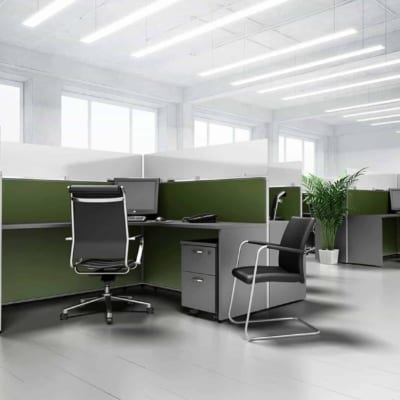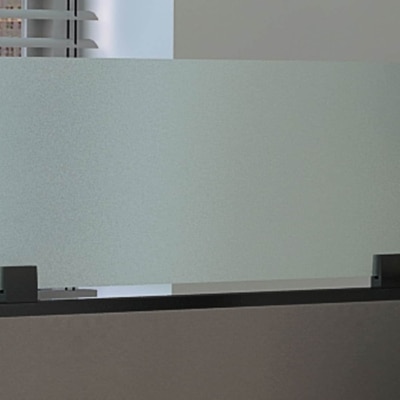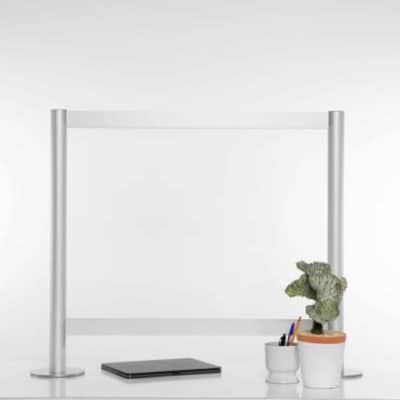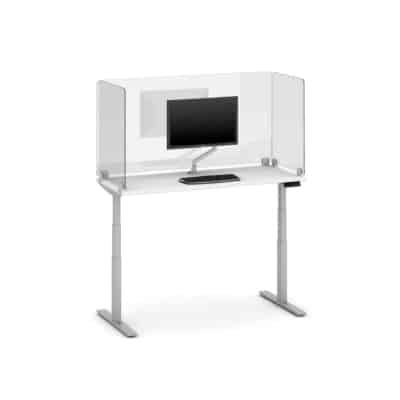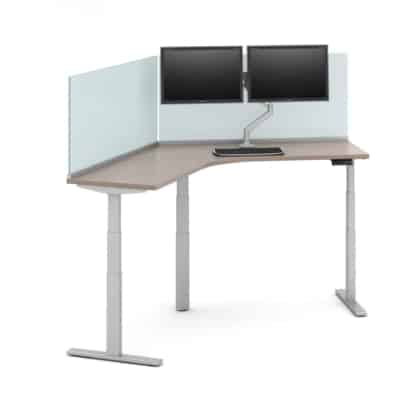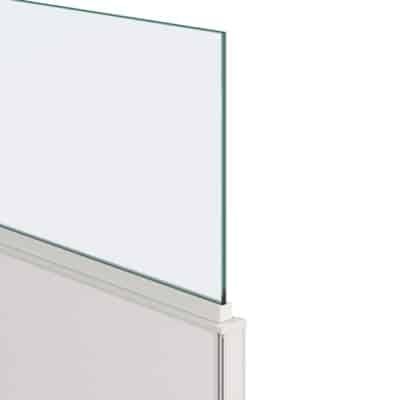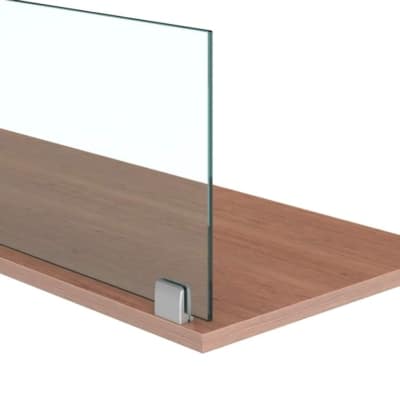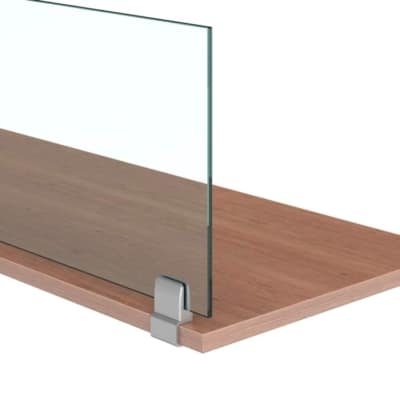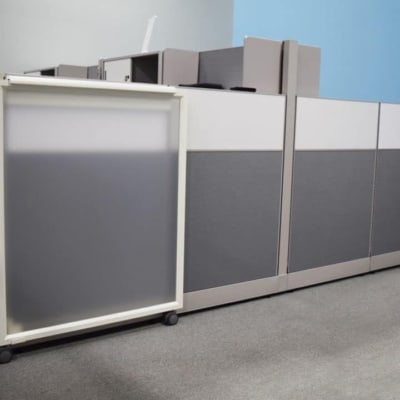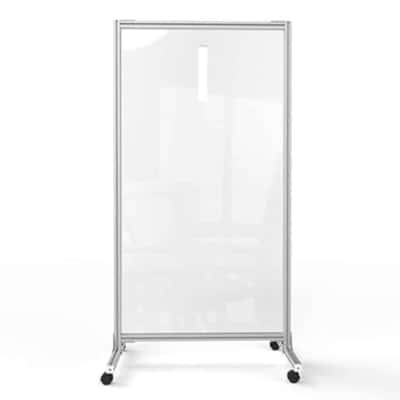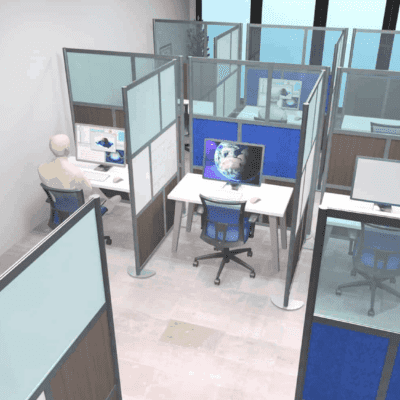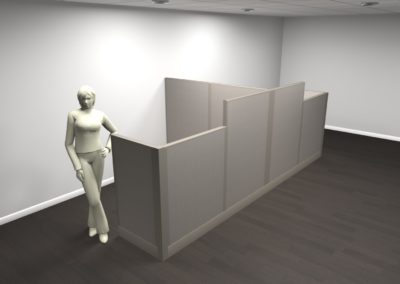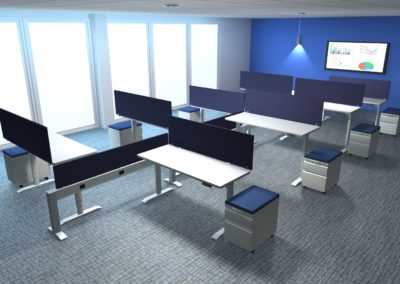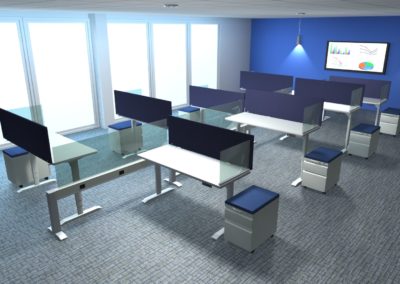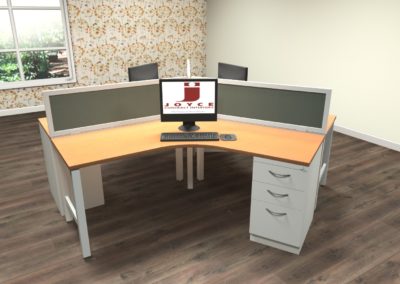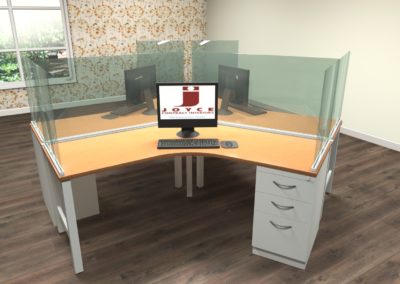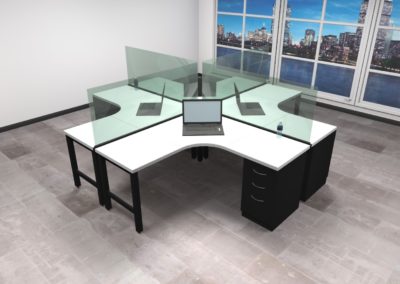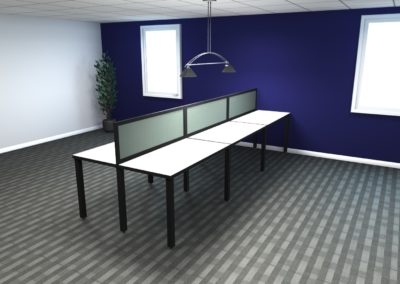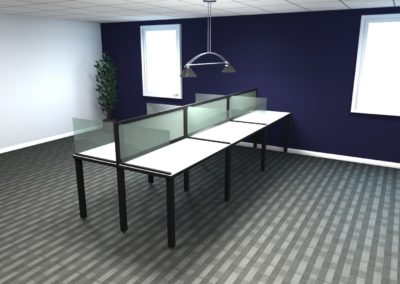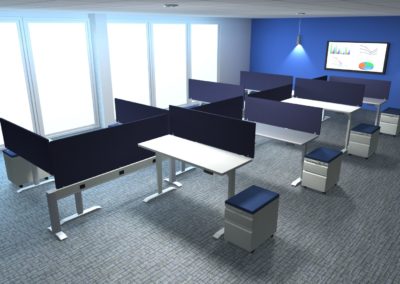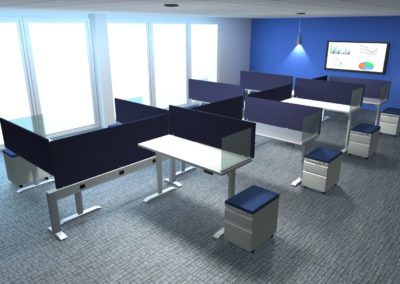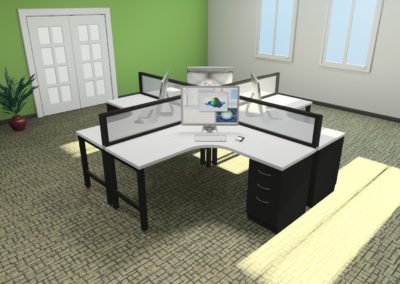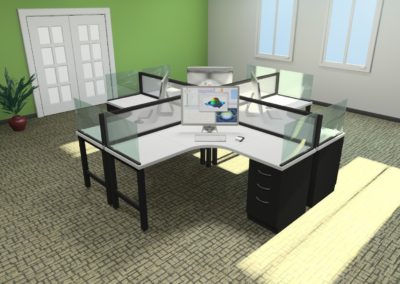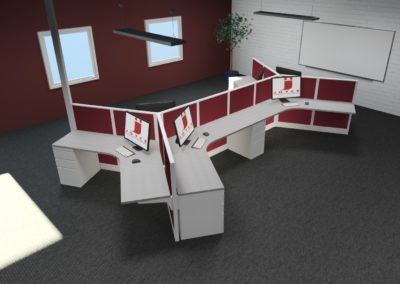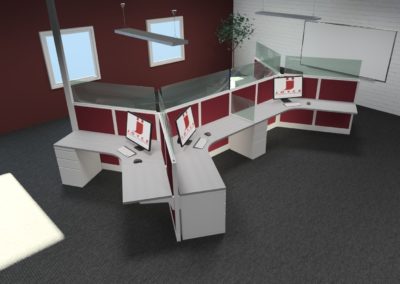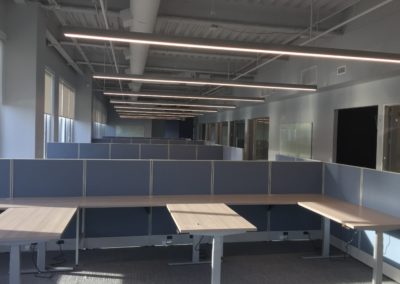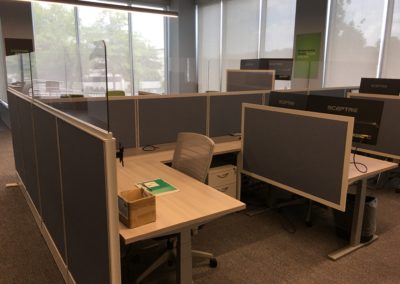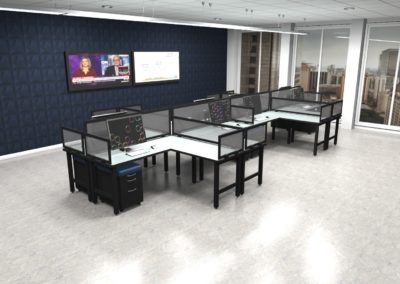Office Dividers
Privacy Dividers for Desks, Cubicles, and Workstations
Manufactured in all shapes, sizes, materials, and finishes, office dividers can be used in a multitude of ways with endless possibilities. In open-plan benching workstations, dividers placed between employees add height separation (12”-30”) and provide personal space. With low-panel workstations, clear dividers/screens on top of panels provide social distancing but maintain the open look of the space.
Shop our divider products below. Explore our buyer’s guide to learn about the different types of dividers that are available depending on your needs and budget. The guide will help you decide on the best option for your office Jump to the buyer’s guide to learn more about dividers.
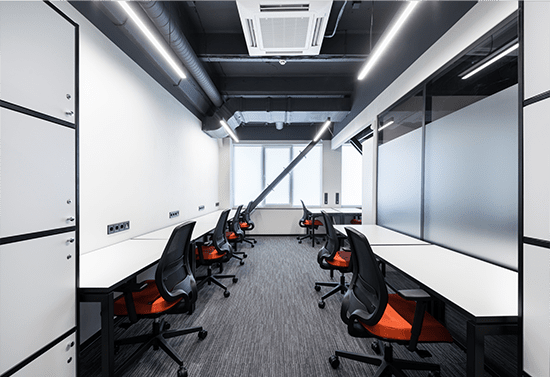
Shop Dividers
Below are some example of existing workstations with dividers or sneeze guards being added to keep your employees 6′ feet apart and safe.
6 Person Dogbone Workstations with Sneeze Guards
Existing 6 Person Dogbone Workstations with Sneeze Guards – After
Existing Workstations with 50H Fabric/16 Lexan Screens – After
Existing Workstations with 50H Fabric/16 Lexan Screens – After
Office Dividers Buyer’s Guide
Office dividers provide value by separating desks, cubicles, workstations, and more. They offer personal space and privacy and limit the spread of airborne germs and viruses. Dividers come in various forms, sizes, materials, and colors to suit different functional and aesthetic needs. Often referred to as panels, partitions, and privacy screens, dividers can be placed between employee workstations to help limit distractions and to adhere to social distancing guidelines. Dividers are excellent options for creating zones in common areas, such as reception lobbies, waiting rooms, or in open-office floor plans.
Office dividers are not limited to fixed panels attached to a wall or desk; they are also available as free-standing and mobile variants. These variants are perfect for open areas that need flexible and temporary separation. Dividers provide flexibility, as they can be reconfigured, moved, or removed in the future. They are ideal for defining space for meetings, communal areas, and corridors.
Divider Uses, Solutions, and Benefits
As the workforce and the digital workplace evolve, the workspace needs to evolve as well. Commerce is fully global and many people now work remotely. The impact of COVID-19 continues to redefine the needs of the office environment. Workplace design must adapt accordingly to be flexible and comfortable and to provide a productive work environment with the right amount of employee privacy.
Privacy

One of the critical benefits of partitions is privacy. With an open office concept, it can be difficult for employees to find a quiet place to focus on work. Not only can productivity be impacted adversely in an open office but, according to a ScienceDirect study, “Women report feeling more visible, watched, observed, and exposed. This increased exposure also makes women feel their appearance is being judged.”
Adding office divider walls or workstation dividers adds cubicle-like privacy that helps minimize distractions. You can get creative with freestanding and mobile dividers, perhaps by including a sliding glass door panel to create an enclosed space.
COVID-19 Safety & Sneeze Guards

Since the outbreak of COVID-19, office partitions have become necessary, as they help prevent virus spread. Desk dividers can help create a safe work environment for employees, which is more important than ever now that employers are asking employees to return to offices.
Accessories like Counter Shield Desk Dividers are affordable methods of providing more sanitary work environments for people in close quarters. If a desk divider does not match your business style, perhaps a sneeze guard would work. Panels come in various sizes and provide quality protection without sacrificing durability.
Partitioning or Separating Areas
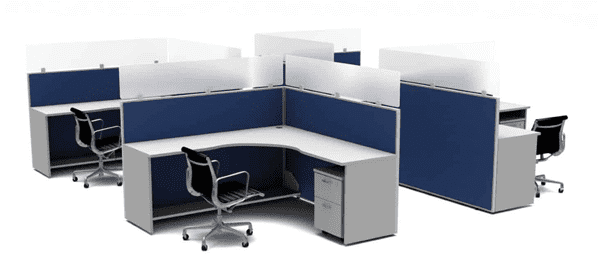
While privacy and safety are essential for a productive work environment, having a functional and stylish space is also important. Office dividers can help you achieve these goals by creating separation where there is no structural separation.
One way to use freestanding and mobile dividers is to create visual barriers between teams or departments that share a large open office space. They can also be used to section off a collaborative area or create a corridor; modular wall dividers are a great option here.
If your office is short on meeting rooms, you can use dividers to partition off space for team huddles. Partitions can create workspaces that vary depending on your needs.
Sound Dampening
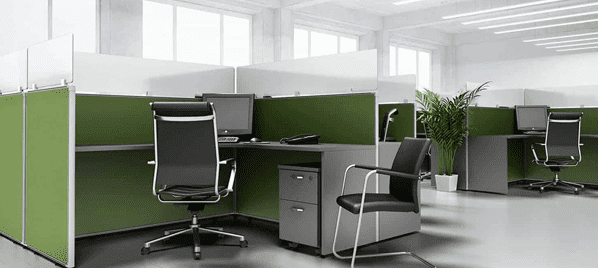
Sound dampening is one of the most important factors in choosing office partitions. Working in a large open room can be noisy and distracting. Office partitions help reduce the amount of noise transmitted between areas of an office.
Sound-dampening materials can help reduce the amount of noise transmitted between different areas. Fabric-covered partitions are one option. Office screens with some sound-dampening material help deaden traveling sound.
Divider Uses, Solutions, and Benefits
There are various materials that you can choose from when it comes to office partitions. The most popular options are clear, including glass, plexiglass, and acrylic material. These materials offer a contemporary, open aesthetic that does not make the workspace feel closed off or confined. Glass has limited ability to absorb sound; consider other materials if sound deadening is important. Fortunately, there are many materials and aesthetics available, each with specific uses and advantages.
Clear vs. Opaque

One of the most important factors to consider is whether you want transparent or opaque office partitions or panels. Clear dividers offer a barrier that retains an open workspace feel, while opaque panels provide more privacy. For balance between the two, frosted glass partitions could be a great option.
Framed or Frameless
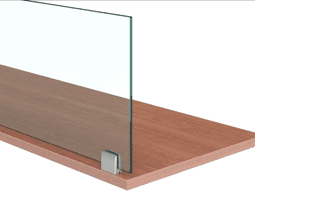
Another choice is framed or frameless partitions. Framed partitions have a more traditional look, while frameless partitions look more modern. The frameless option is more expensive and less durable than framed single-pane panels. However, framed glazing is less attractive than frameless partitions. Frames make the glass appear bulkier, which is usually less attractive.
Materials

In addition to glass, there are other materials to choose from. Office partitions can be made from metal, plexiglass, plastic, and acrylic. Each material has specific uses and benefits.
– Metal is an excellent choice if you are looking for a more industrial look. It is also durable and can be used in high-traffic areas.
– Plexiglass is a lightweight and shatter-resistant material that is ideal for high-traffic areas.
– Plastic is an excellent choice if you are looking for an inexpensive option. It is also lightweight and easy to clean. Acrylic is a shatter-resistant material that is ideal for high-traffic areas.
Styles And Construction
Partitions come in a variety of styles, from traditional to modern. The most popular style is the free-standing partition that can be used to create different office layouts.
Free-standing vs. Extending
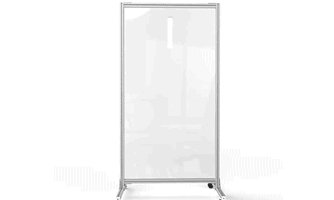
Freestanding partitions are the most popular type of office partitions. They are easy to install and can be used to create various office layouts. Extending partitions are ideal if you need more flexibility with your office layout. They can create temporary walls and be extended or retracted.
Folding vs. Flat
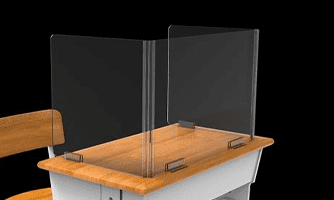
Folding partitions are a great choice if you need to create temporary wall dividers on desks or other work surfaces. They are easy to install, have mounting adhesive, and can be stored away when not in use. Flat partitions are also popular. They are easy to install and can be used to create a variety of office layouts.
Fixed vs. Modular

Fixed partitions work well if you need to create a more permanent wall or divider. They are usually made of wood or metal and can be painted or stained to match office décor. Modular partitions can be used to create a temporary wall or divider. They are usually made of plastic or acrylic and can be connected to create various shapes and sizes.
Office Layout Considerations
Dividers offer designers flexibility in creating an office layout. If parameters change, dividers can be used to update the office plan as needed. Reflecting on how the workplace has shifted in just the past decade, it is clear that this flexibility is quite valuable.
Office designers may utilize dividers to help balance the benefits of an open office layout and the virtues of separation and privacy. Dividers can help achieve this balance when more permanent structural elements in the office would limit flexibility.

